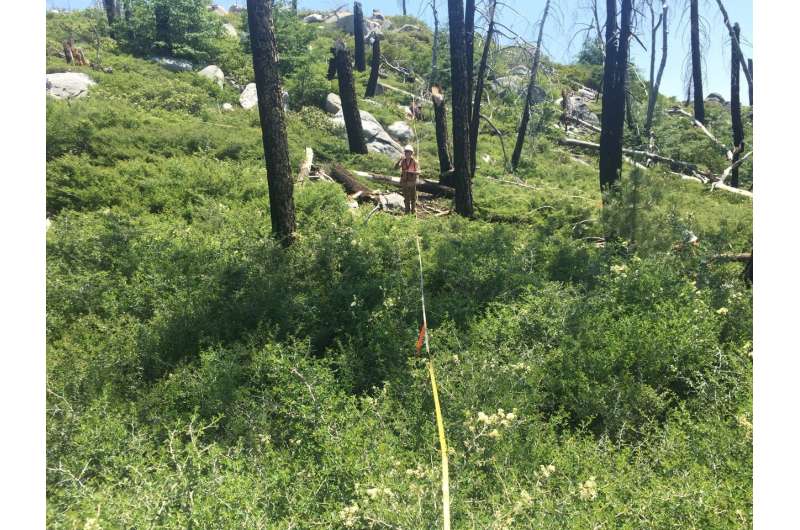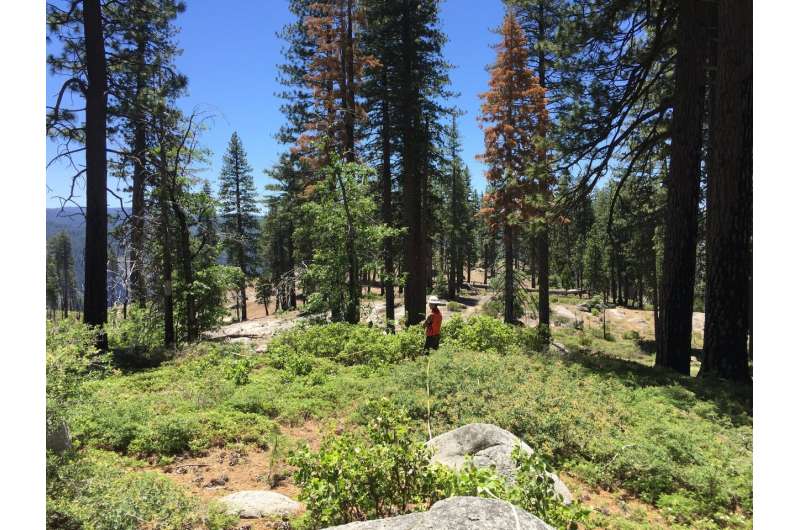UC Davis' Clark Richter investigates plant diversity within a transect line of a Sierra Nevada forest affected by drought and wildfire. Credit: Clark Richter
Sierra Nevada forests are losing plant diversity due to high-severity fires, according to a study from the University of California, Davis. These fires are turning patches of forest into shrub fields—indefinitely, in some cases.
For the study, published in the journal Ecosphere, scientists analyzed plant diversity across a spectrum of fire severity—from low to moderate to high. They found the sweet spot for plant diversity exists where tree stands burned with low-to-moderate severity, as mixed conifer forests did in this region for millennia before the imposition of fire suppression policies in the early 20th century. Such policies have greatly increased forest density and the amount of woody fuels in many California forests and led to more severe, stand-replacing fires.
On the extreme ends of the spectrum, unburned areas and high-severity burn areas showed relatively low plant diversity. Five to 10 years or more after experiencing high-severity burns, many forest stands were replaced by shrub fields that supported few plant species.
'A different kind of fire'
The results suggest these forests, which are used to living with and even benefiting from fire, have not yet adapted to this newer regime of intense, high-severity fires.
"This system is experiencing a different kind of fire," said lead author Clark Richter, a doctoral candidate at UC Davis. "The species are outside of their limits. More high-severity fires greatly change a diverse and highly varied forest to one where all the trees are dead and what's left is often just a few species of shrub, not the herbs and wildflowers you may be used to seeing."
The researchers examined postfire plant response in eight areas of yellow pine and mixed conifer forests that burned in California's Sierra Nevada between 2001 and 2012. These areas have experienced among the biggest increases in wildfire size and severity over the past 30 years in the continental United States. The areas stretched from the site of the Moonlight Fire (2007) in Lassen County southward to the Power Fire (2004) in Amador County.
Researcher Paul Excoffier during field work about plant diversity and wildfire in the Sierra Nevada. Credit: Clark Richter, UC Davis
Trends call for multi-pronged approach
The study states that under climate change and current fire trends, "there is a real possibility that large portions of the Sierra Nevada landscape could be caught in a feedback-loop" that prevents recovery of former forest.
"We will need enhanced management tools and resources to help forests adapt if we want to preserve plant diversity for soil, animal and ecosystem health," Richter said.
The paper suggests a multifaceted management approach that combines forest thinning with a major expansion of prescribed burning and allowing naturally ignited fires to burn under moderate weather conditions.
More information: Clark Richter et al, The species diversity × fire severity relationship is hump‐shaped in semiarid yellow pine and mixed conifer forests, Ecosphere (2019). DOI: 10.1002/ecs2.2882
Journal information: Ecosphere
Provided by UC Davis

























